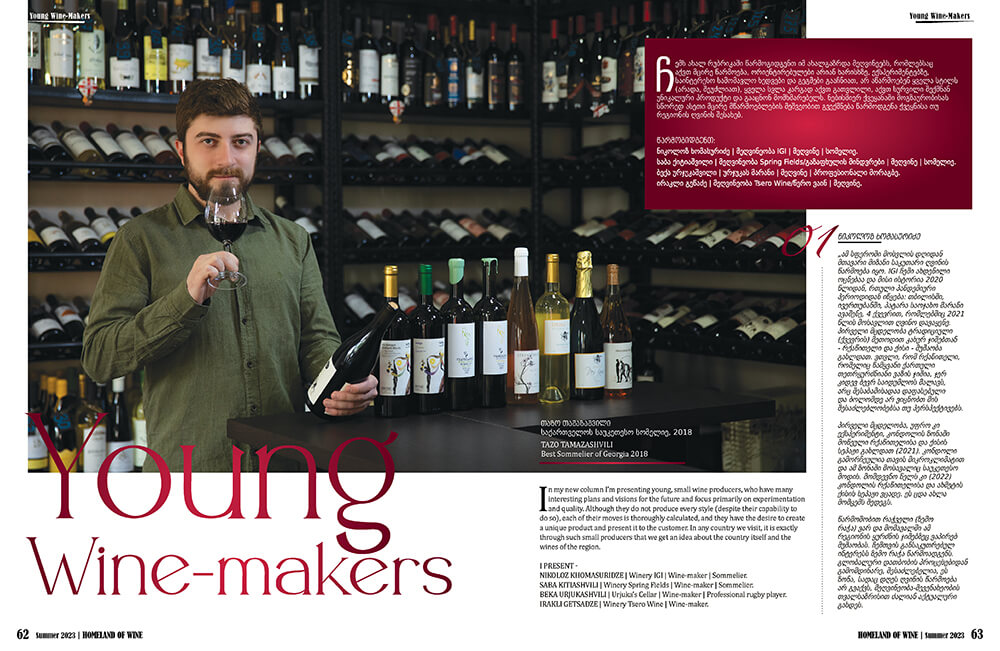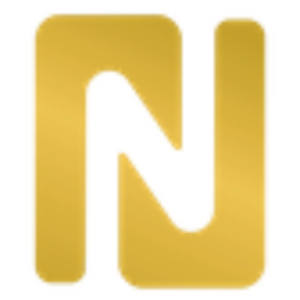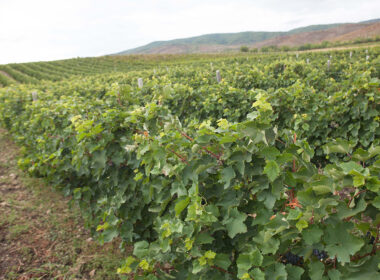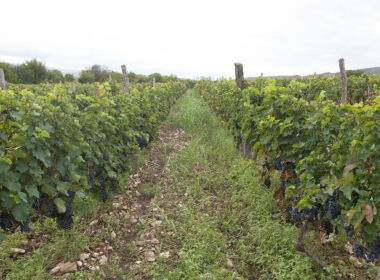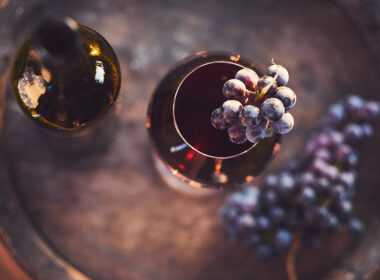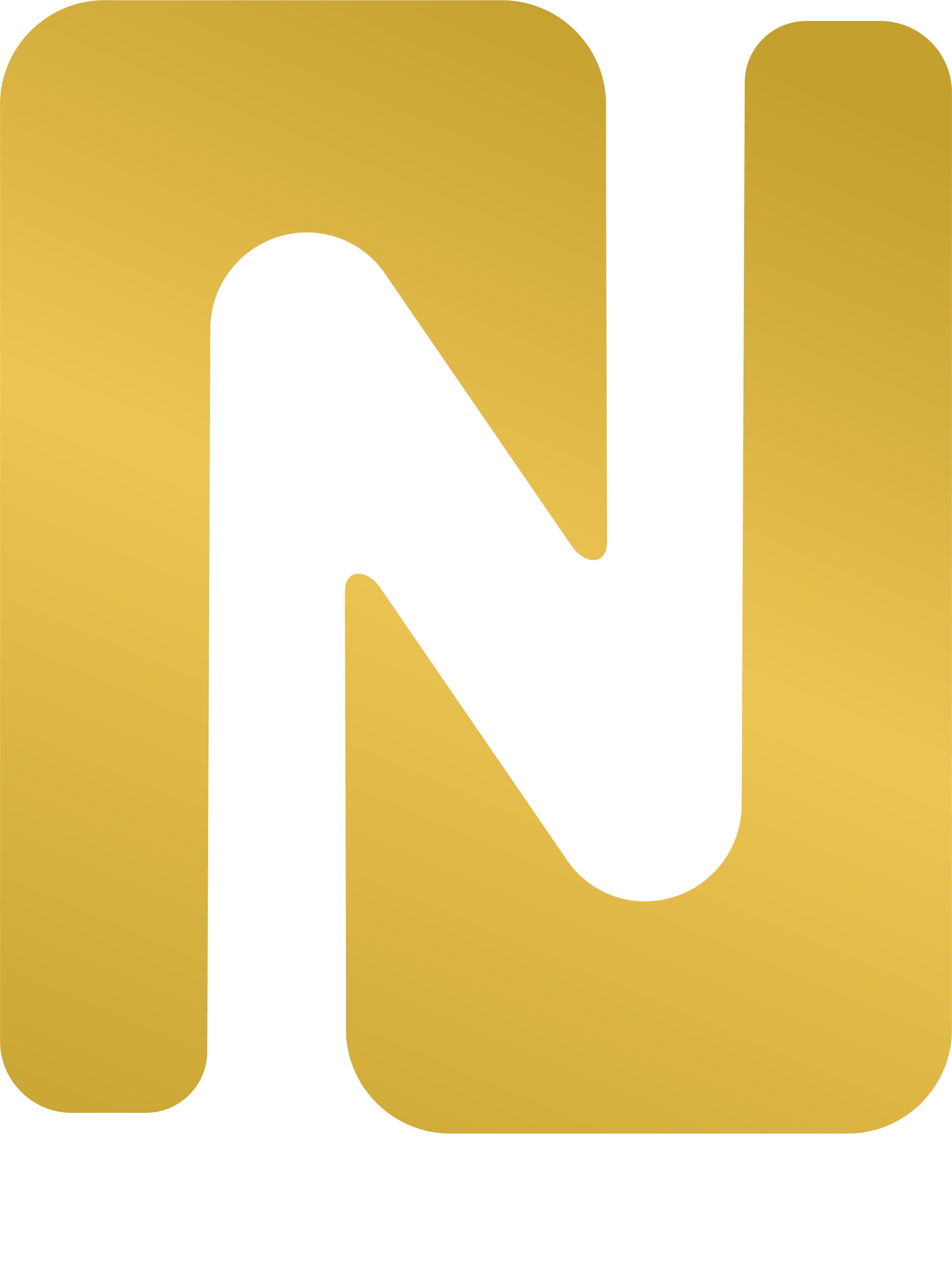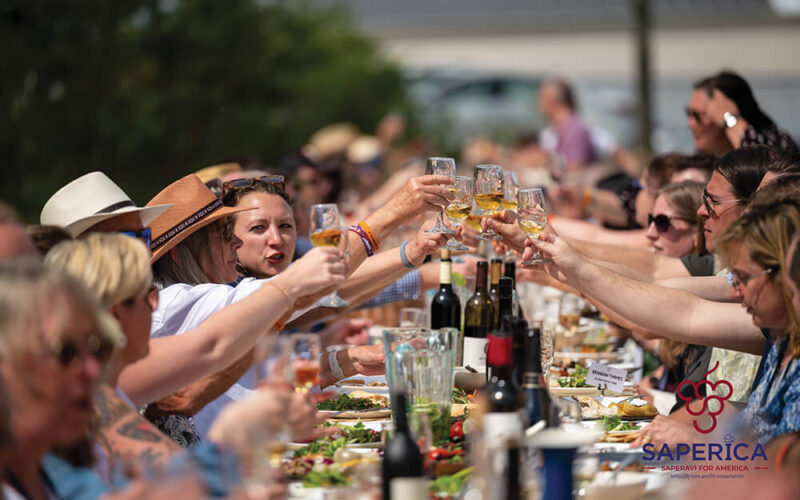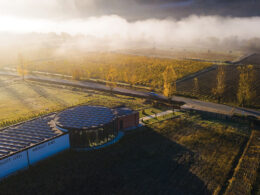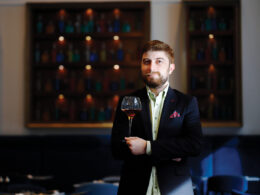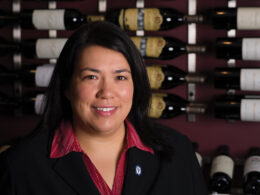By Tazo Tamazashvili | Best Sommelier of Georgia 2018
In my new column I’m presenting young, small wine producers, who have many interesting plans and visions for the future and focus primarily on experimentation and quality. Although they do not produce every style (despite their capability to do so), each of their moves is thoroughly calculated, and they have the desire to create a unique product and present it to the customer. In any country we visit, it is exactly through such small producers that we get an idea about the country itself and the wines of the region.
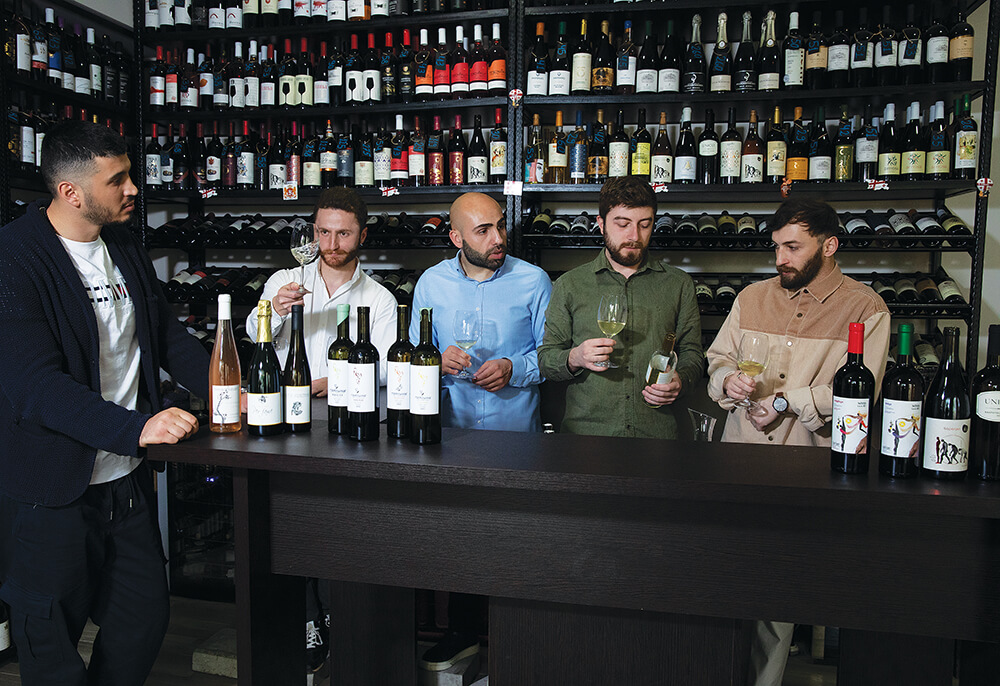
I present –
Nikoloz Khomasuridze | Winery IGI | Wine-maker | Sommelier.
Saba Kitiashvili | Winery Spring Fields | Wine-maker | Sommelier.
Beka Urjukashvili | Urjuka’s Cellar | Wine-maker | Professional rugby player.
Irakli Getsadze | Winery Tsero Wine | Wine-maker.

Nikoloz Khomasuridze
“From the day I began working in this field, my main goal was to produce my own wine, IGI for me, is a dream come true. Its history starts from a very difficult period during the pandemic in 2020, when, in Tbilisi’s Ivertubani, I built a small, family wine cellar with 4 kvevris, in which I stored the wine made from the harvest of 2021. My first attempt was working with Kakhetian grape varieties Rkatsiteli and Kisi- using the traditional (kvevri) method.
I believe that Rkatsiteli, which is a leading Georgian white grape variety, still harbours many secrets and is not deservedly appreciated, neither are we fully aware of its capabilities nor prospects.
The first attempt, which was more of an experiment, was the cépage of Rkatsiteli and Kisi varieties harvested in the Kondoli zone. Kondoli is exceptional with its microclimate, and in this area the harvest is the finest too. In the following year (2022) I tried Kondoli Rkatsiteli and Kisi of Akhmeta cépage. The result of this endeavour is yet to be seen.
Originally, I come from Racha (upper Racha,) and in the future I plan to work with the grape varieties of that region as well. I am particularly interested in the upper Racha region due to the effects of global warming. It is possible that this part of the region, where to this day wine is not being produced, can become extremely vital in terms of winemaking and winegrowing.
While establishing IGI, the main source of my inspiration was Jemal Karchkhadze’s novel of the same title, where a human being of the antiquities period comes out of a cave and through acquiring knowledge, slowly begins to stand upright. This premise is exactly what is depicted on our labels as well. Despite our centuries long wine-making traditions, due to objective reasons, we are still in the development stage. That is why I wish for IGI to become one of the participants in this process of development.”
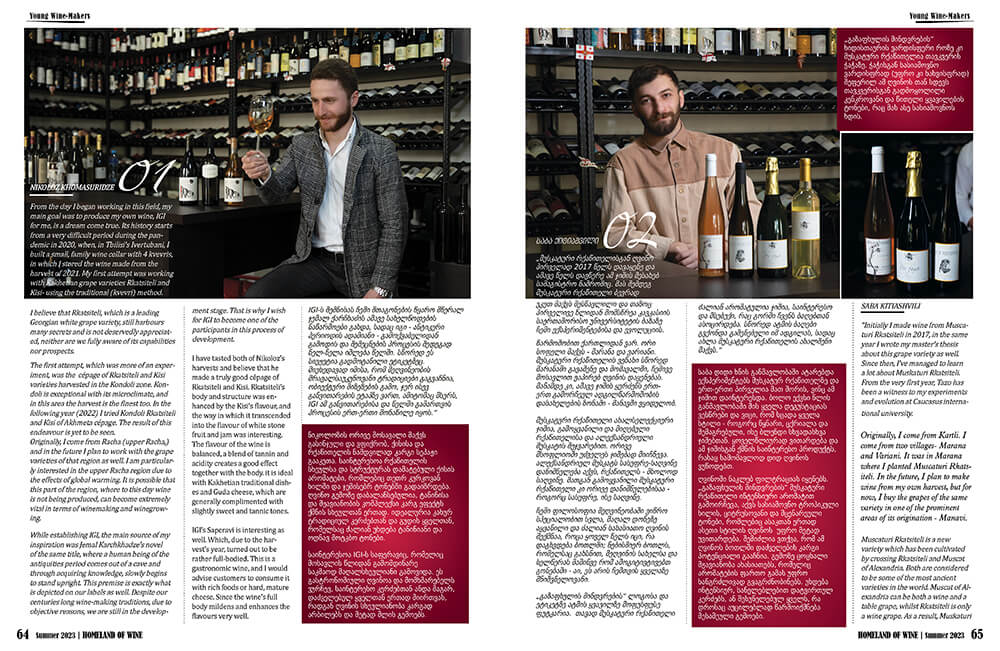
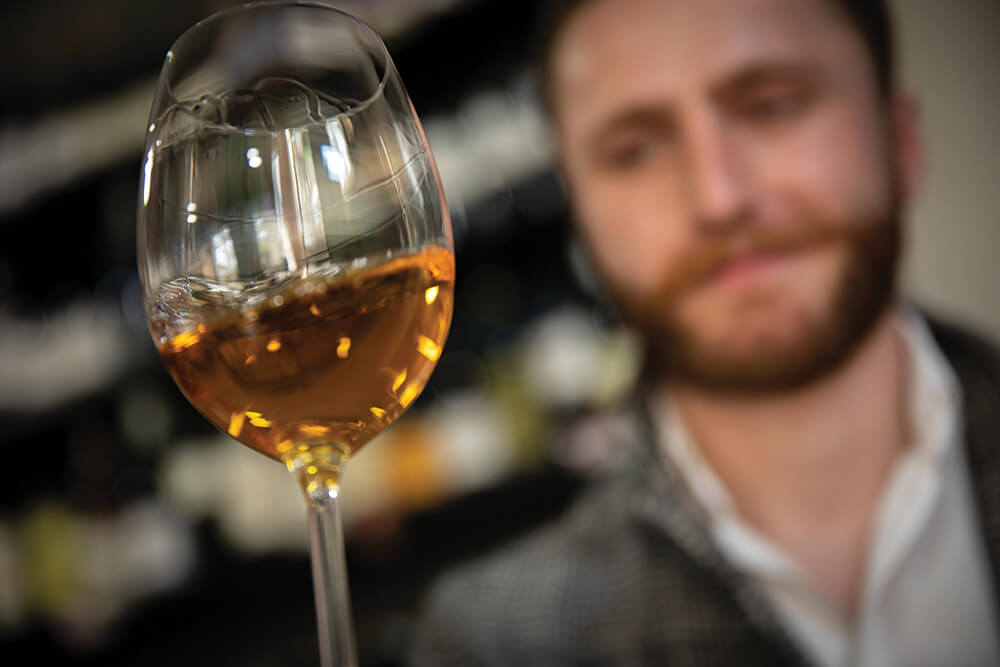
TAZO TAMAZASHVILI: I have tasted both of Nikoloz’s harvests and believe that he made a truly good cépage of Rkatsiteli and Kisi. Rkatsiteli’s body and structure was enhanced by the Kisi’s flavour, and the way in which it transcended into the flavour of white stone fruit and jam was interesting. The flavour of the wine is balanced, a blend of tannin and acidity creates a good effect together with the body. it is ideal with Kakhetian traditional dishes and Guda cheese, which are generally complimented with slightly sweet and tannic tones.
IGI’s Saperavi is interesting as well. Which, due to the harvest’s year, turned out to be rather full-bodied. This is a gastronomic wine, and I would advise customers to consume it with rich foods or hard, mature cheese. Since the wine’s full body mildens and enhances the flavours very well.
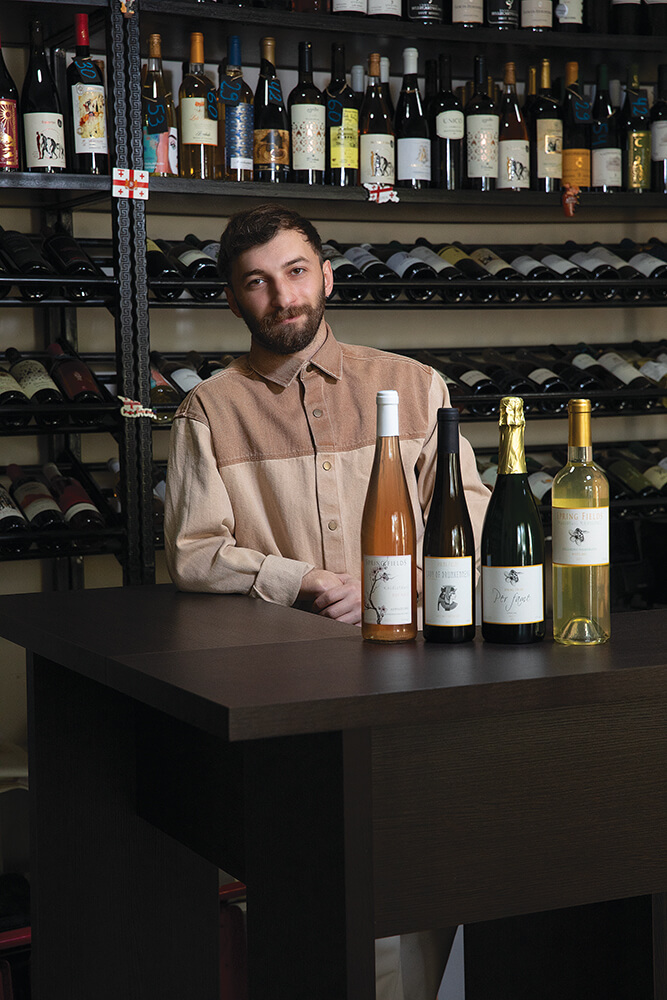
Saba Kitiashvili
“Initially I made wine from Muscaturi Rkatsiteli in 2017, in the same year I wrote my master’s thesis about this grape variety as well. Since then, I’ve managed to learn a lot about Muskaturi Rkatsiteli. From the very first year, Tazo has been a witness to my experiments and evolution at Caucasus international university.
Originally, I come from Kartli. I come from two villages- Marana and Variani. It was in Marana where I planted Muscaturi Rkatsiteli. In the future, I plan to make wine from my own harvest, but for now, I buy the grapes of the same variety in one of the prominent areas of its origination – Manavi.
Muscaturi Rkatsiteli is a new variety which has been cultivated by crossing Rkatsiteli and Muscat of Alexandria. Both are considered to be some of the most ancient varieties in the world. Muscat of Alexandria can be both a wine and a table grape, whilst Rkatsiteli is only a wine grape. As a result, Muskaturi Rkatsiteli, which is cultivated from the two, is both a table and wine grape.
My philosophy in wine making is to continue with a narrow profile, create a wine of a very high standard and of unique character, and know every year what you’ll find inside the bottle. So, when opening any bottle, you will remember the name and the signature of the winemaker immediately. This is what’s most important for me.
The label of Spring Fields is a bee hovering over a peach blossom. Muskaturi Rkatsiteli itself is a very aromatic variety, notable and light, which can be associated with our gardens in the town of Gori. We used to have peach gardens in the place of the current Muskaturi Rkatsiteli vineyard.”
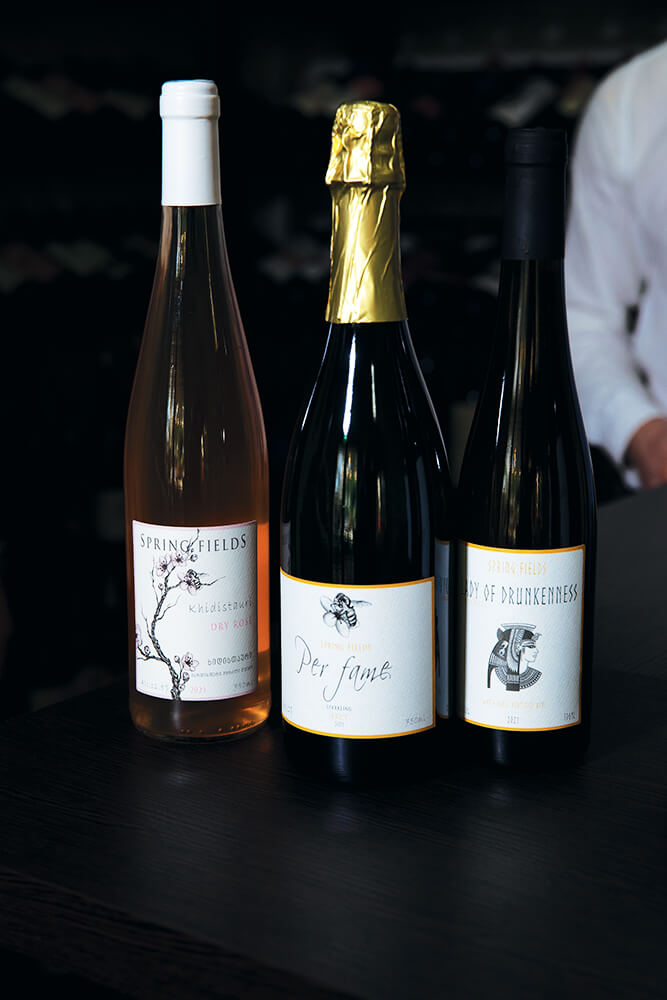
TAZO TAMAZASHVILI: Saba was experimenting on Muskaturi Rkatsiteli for a long time, he was one of the first among those who took interest in this variety. For the past 6 years I have attended every tasting he held, and I know that he has tried every style including mellow, sparkling, and cooling, as well as blending with other varieties. He improves every year, and from this variety he is creating an interesting product, which in future we will call a great wine.
He is using less filtration in wines. Spring Fields Muskaturi Rkatsiteli is notable for the intensity of its flavour, which has pleasant tropical fruit, citrus, and plant undertones, which with aging, just develops more in this type of wine. I can say that this wine has good potential for aging in the bottle. Its lively acidity prolongs the effect of its wide range of flavours, it is suited for intensive, heavily spiced dishes or spiced cheese.
Spring Fields pink Rose of Khidistauri is a Muskaturi Rkatsiteli fermented with Tavkveri’s Chacha (pomace). In this wine, which has a pleasant pink colour (more like the colour of an onion,) induced by Chacha, undertones of red flowers and berries carried over from Tavkveri can be detected, which makes it very pleasant.
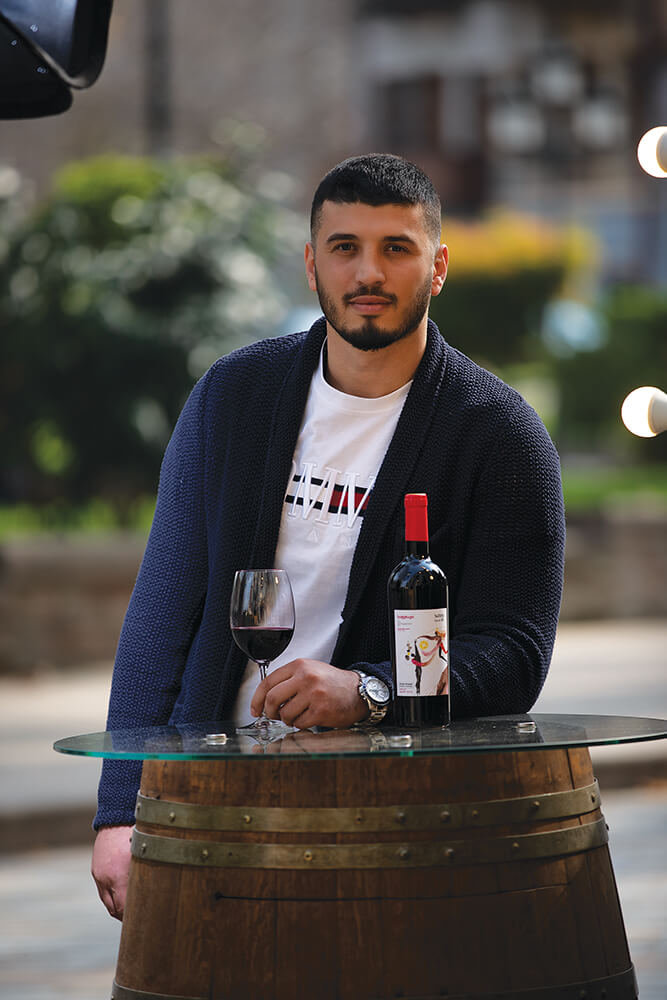
Beka Urjukashvili
“Wine making is our family tradition. Since childhood, I used to observe the process in our wine cellar. Recently, I have become actively involved in wine making myself. I didn’t think that aside from Rugby, that I would be able to get involved with something so deeply and with love. Today, together with my father, we own Urjukas Marani. We are “Urjukas” which means “elusive” and “a freedom fighter.”
For the first time we made wine in a bottle last year, in a small quantity, in our winery which is situated in the village of Patardzeuli. On these lands years ago, everybody had the best vinyards, and the grapes were outstanding too. Today due to objective reasons, the situation has changed. I absolutely have a great desire to return the grape vine to Patardzeuli. I am planning to plant the vine in a place which has been stuck in my childhood memories.”

TAZO TAMAZASHVILI: Beka produces Kakhetian wines, amongst them is Khashmis Saperavi which has a good potential for aging. The wine is an intensive ruby colour with aromas of black cherry, black plum, black pepper, and an earthy undertone characteristic to the variety which is well detectible and significant to the Khashmi’s place of origin. Despite it being a young wine (2022), it is well rounded, a complex of tannins and acidity, is well refined, and created an ideal balance together with its full body. As I’ve already mentioned, this wine has a huge potential to be aged in the bottle after which the earthy tones will transcend into smoky and spicy flavours which is considered delicate for the wines of this body.
In Kakheti we have a lot of dishes which can go well with this type of wine, amongst them, my favourite is veal’s Chashushuli in Saperavi. Since the wine is so intensive, it will be a great accompaniment to a baked lamb as well.
As for the white blends of Urjukas Marani such as Rkatsiteli and Manavis Mtsvane-they are quite flavourful. Immediately after pouring it into a wine glass, characteristics of Mtsvane undertones of white fruits and flowers erupt. It’s velvety and pleasant to drink.
These gastronomic wines can be paired well with a Kakhetian style of cuisine and dishes that are meat rich from various parts of Georgia.
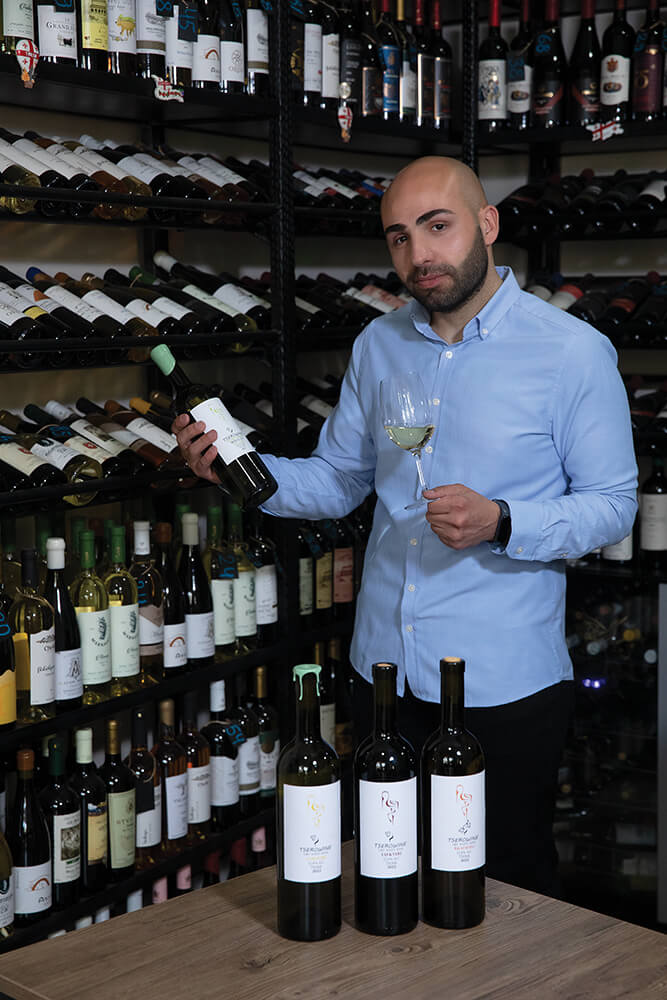
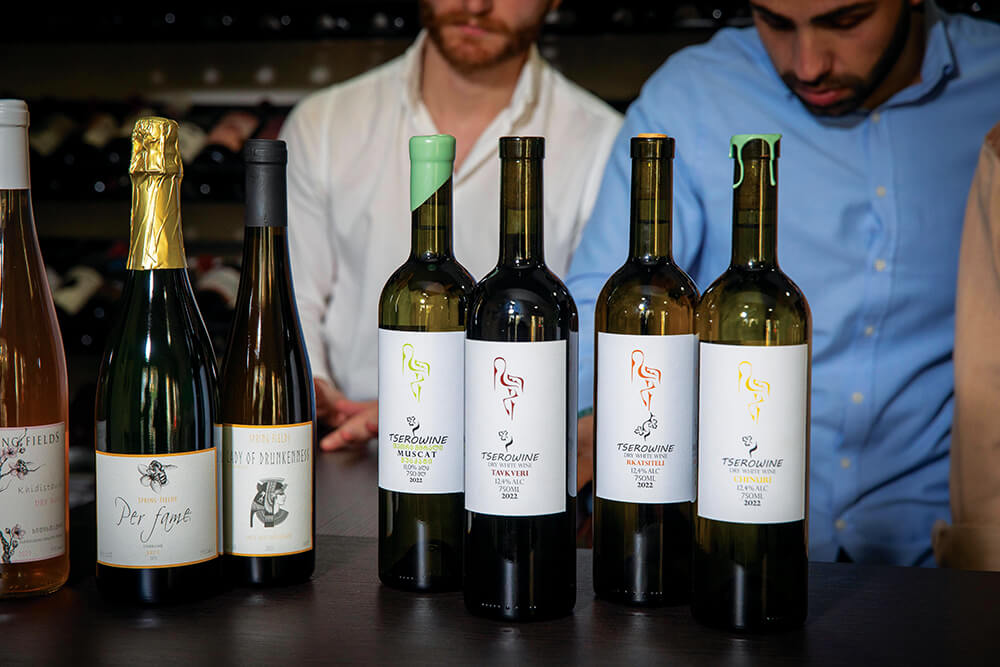
Irakli Getsadze
“The history of Tsero Wine winery starts from 2019. Before, this was a course for agricultural business management, and later for a few years, I was working in the field of engineering.
As for the winemaking field, I used to observe it from a distance with great interest. Like most Georgian families, we too owned a vineyard, and in a family environment, members of the older generation always used to make wine. However, my aim was to produce the type of wine which could be represented on the market as a quality product.
In 2019, whilst still working as an engineer for one of the companies, I decided to attend a wine making course. I immediately realised that I had a lot to learn to be able to produce a quality wine, therefore, soon after, I made the decision to continue my studies at the Agricultural university. During the first lecture I realised that this was exactly what I wanted to learn and do, so I decided to quit my job and switched to wine making fully. From this time starts the history of Tsero Wine.
In 2019, from the harvests of our own vineyards, I made my first wines, Chinuri and Tavkveri. It’s the third running year, and I’ve added more varieties of Tsero wines, besides Tavkveri and Chinuri, I added Muskaturi Rkatsiteli and Saperavi. Tavkveri, Chinuri and Rkatsiteli varieties come from my own vinyards, whilst I buy Saperavi in the Mukuzani zone.
The name of the winery Tsero Wine comes from our village Tserovani: during times of bird migration, Storks (tsero) would rest here – Tseros’ Vani.”
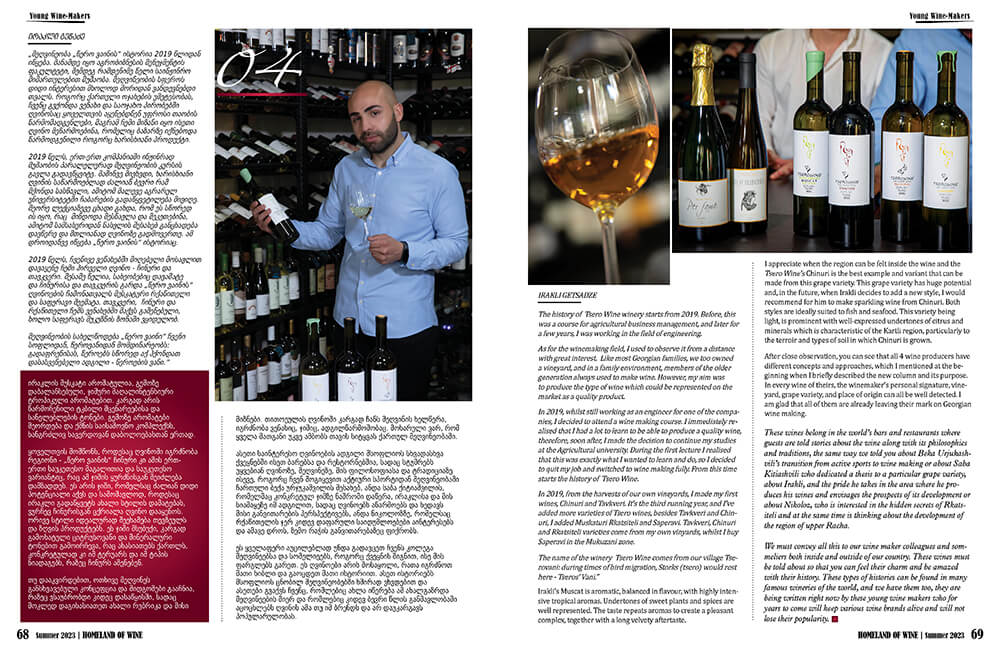
TAZO TAMAZASHVILI: Irakli’s Muscat is aromatic, balanced in flavour, with highly intensive tropical aromas. Undertones of sweet plants and spices are well represented. The taste repeats aromas to create a pleasant complex, together with a long velvety aftertaste.
I appreciate when the region can be felt inside the wine and the Tsero Wine’s Chinuri is the best example and variant that can be made from this grape variety. This grape variety has huge potential and, in the future, when Irakli decides to add a new style, I would recommend for him to make sparkling wine from Chinuri. Both styles are ideally suited to fish and seafood. This variety being light, is prominent with well-expressed undertones of citrus and minerals which is characteristic of the Kartli region, particularly to the terroir and types of soil in which Chinuri is grown.
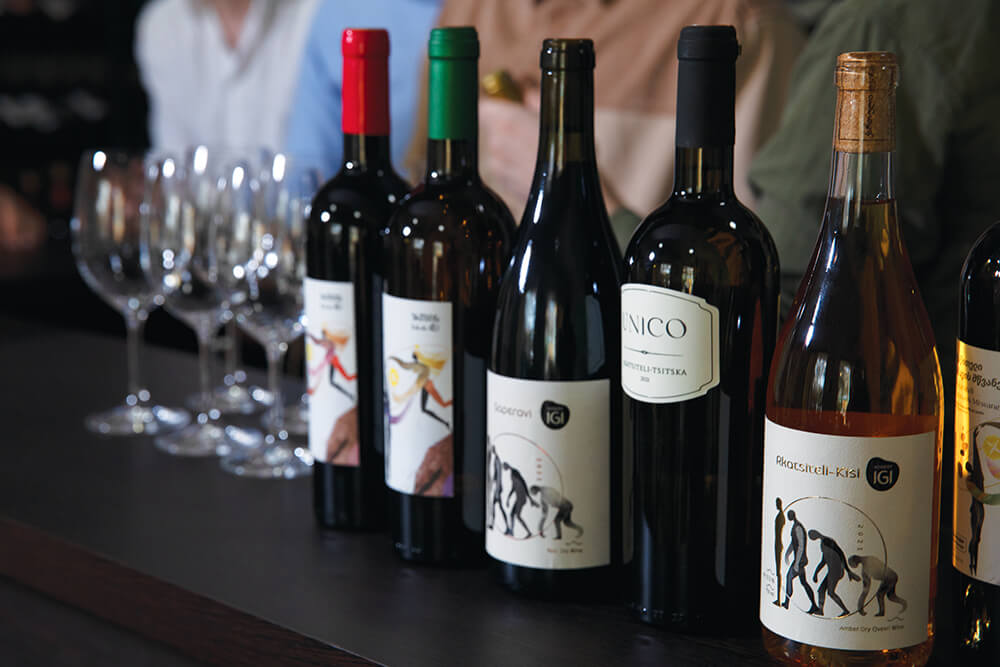
After close observation, you can see that all 4 wine producers have different concepts and approaches, which I mentioned at the beginning when I briefly described the new column and its purpose. In every wine of theirs, the winemaker’s personal signature, vineyard, grape variety, and place of origin can all be well detected. I am glad that all of them are already leaving their mark on Georgian wine making.
These wines belong in the world’s bars and restaurants where guests are told stories about the wine along with its philosophies and traditions, the same way we told you about Beka Urjukashvili’s transition from active sports to wine making or about Saba Kitiashvili who dedicated a thesis to a particular grape variety, about Irakli, and the pride he takes in the area where he produces his wines and envisages the prospects of its development or about Nikoloz, who is interested in the hidden secrets of Rkatsiteli and at the same time is thinking about the development of the region of upper Racha.
We must convey all this to our wine maker colleagues and sommeliers both inside and outside of our country. These wines must be told about so that you can feel their charm and be amazed with their history. These types of histories can be found in many famous wineries of the world, and we have them too, they are being written right now by these young wine makers who for years to come will keep various wine brands alive and will not lose their popularity.

